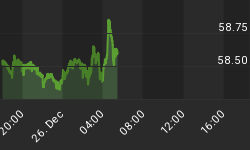You've probably noticed the recent spate of articles and news stories documenting the rise in global food prices.
If you've been out shopping for food items, or live in a country facing unrest due to these problems, then you've experienced this trend firsthand.
Today we're going to review some previous posts and include a few new items that address this topic. But first, let's look at the trend towards increased news coverage of this topic.

Increased Attention to Rising Food Prices
As you can see from the Google Trends graph, search volume for the query, "food prices", has been appeared pretty stable over the past several years, with a recent rising trend from 2007 into 2008.
What's very notable in this chart is the surge in news reference volume; since the start of 2007, the pattern of occasional upsurges in news on food prices has been replaced with a steadily rising trend in news coverage and reference volume. Note the surge in news items going into this most recent period of 2008.
We can verify this with a simple Google News keyword search. Type in "food prices" (with the phrase in quotes) for the period March 1, 2007 through March 31, 2007, and you'll see Google return 513 results.
The same search for March 1, 2008 through March 31, 2008 yields 1,980 news results. I'd say that a more than threefold increase in news stories (year-over-year) addressing the same topic is a noteworthy trend.
Crisis = Coverage
What's behind the surge in news coverage? The answer is a rise in global food prices and agricultural commodities that seems to have taken much of the world by surprise.
But now that we're in crisis mode, we hear the "world leaders" calling for action.
"THE World Bank has issued an urgent call to rich nations to help stem rising food prices, warning that social unrest in poor countries is spreading and that 100 million people are at risk of being plunged deeper into poverty.
"We have to put our money where our mouth is now, so that we can put food into hungry mouths. It is as stark as that," said World Bank president Robert Zoellick, as he called for more contributions to the $500 million World Food Program.
The plea, issued after a meeting of aid officials in Washington, follows a dramatic surge in world prices for staple foods -- rice, for example, has shot up by 75% in just two months -- and resulting food-related riots in Haiti, Indonesia, the Philippines and Cameroon in the past week."
Now let me to pose a simple question to these so-called world leaders. What did you expect?
Without getting too bogged down in the details of why agricultural commodity prices are shooting up, let's consider the following trends.
Factors Driving Higher Prices
You have increased consumption of food and grains (and grain-fed animals) in huge developing countries like China and India, and across the globe. That's right, global leaders: increased supply and demand.
We also see rising energy prices in an age of energy-intensive farming. Water shortages, land shortages; think about the land shortages for a second.
You have governments and international agencies promoting hydro dam projects that, as I understand it, flood existing villages and acres of farmland.
There is the relentless urbanization of the Chinese landscape, which is taking over much of that country's arable land. In America, we've seen suburban sprawl and commercial development take over much of our rural landscape, paving over many former ranches and farms.
Next, factor in government subsidies and mandates for ethanol produced from crops, disastrous policies which have misallocated resources and shifted incentives towards the production of crops for biofuel, rather than food.
Biofuels production, combined with notable crop failures, have led to dwindling stockpiles of grain worldwide. This, in turn, has led to growing social unrest for countries facing food shortages, and an upsurge in food riots across the globe.
Finally, add several years of rampant increases in money supply (inflation) worldwide, and you are bound to see higher prices for almost any tangible asset, especially much needed commodities and food items in short supply.
Summing Up
As you can see, there have been many forces at work driving this trend towards higher food prices, despite earlier protests to the contrary from lobbyists, certain members of the media, and governments.
I'm sure readers with a better understanding of agriculture and farming could provide a more detailed explanation (or rebuttal) of these points, but the main idea is clear. Rising demand for food has been met with a shrinking supply of arable land and falling global stockpiles of crops, and the result is higher prices.
For more, please see:
"Why costs are climbing" - Globe and Mail.
"On agricultural commodity prices" - Finance Trends Matter.
"Agflation is the new buzzword" - Finance Trends Matter.















